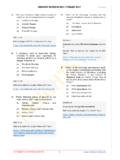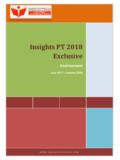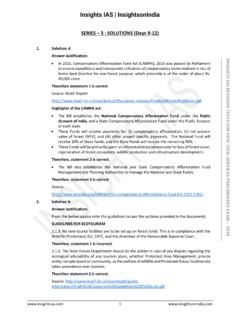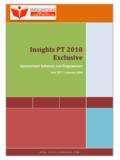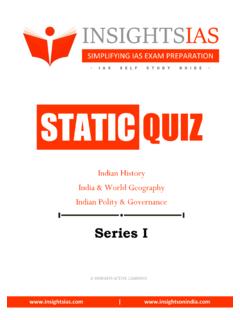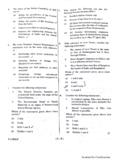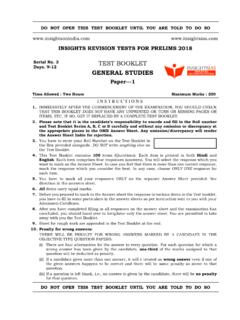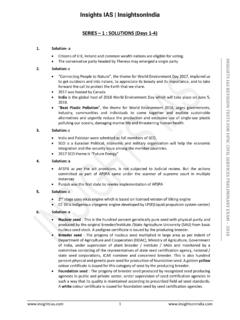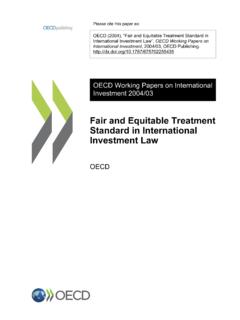Transcription of 6.Science and Technology - INSIGHTSIAS
1 And TechnologyScience and Technology in India1. India boasts of many contributions such as the first use of zero asrevealed by the Bakshali manuscript. However, India now needs to lookahead of its past laurels and move from being a net consumer ofknowledge to becoming a net producer as it emerges as one of theworld s largest economies. According to WIPO, India is the seventhlargest patent filing office in the world. However, India produces fewerpatents per capita. 2. Current situation1. India has become a major destination for outsourced R&Dactivities. We currently have more than 1,100 R&D centres set upby MNCs such as IBM, Google, etc.
2 2. Indian scientists are at the forefront of some globalgroundbreaking work. For example, 37 Indian scientists from nineIndian institutions played a key role in the discovery ofgravitational waves that received the Physics Nobel prize in scientists also contributed to the discovery of a neutron starmerger at Laser Interferometer Gravitational Wave Observatory(LIGO), USA. 3. The development of Brahmos, advanced air defence supersonicinterceptor missiles, diverse missiles and rocket systems, remotelypiloted vehicles, light combat aircraft (LCA), etc., are brilliantexamples of India s progress in strategic and defencetechnologies.
3 4. India now ranks amongst a handful of nations that have crediblecapabilities in the field of space Technology . The upgrading fromSLV to ASLV and PSLV to GSLV, the first moon orbiter projectChandrayan-1, Mars Orbiter Mission (MOM) at the cheapestprice and the recent simultaneous launch of 104 satellites areIndia s significant achievements. 5. India is now the third largest country in terms of the number ofstart-ups. The government has set up the Atal Innovation Mission(AIM) to transform radically the innovation, entrepreneurship andstart-up Importance1. Science, Technology , and innovation have instrumental andintrinsic value for society.
4 They are key drivers of economicperformance and social It is also important for driving scientific temper, with its spirit ofenquiry, the primacy accorded to facts and evidence, the ability tochallenge the status quo, the adherence to norms of discourse andthe elevation of doubt and The open spirit of inquiry that is fundamental to science canprovide a bulwark against the darker forces of dogma, religiousobscurantism, and nativism that are threateningly resurfacingaround the It is also essential for human security, for combating climatechange as well as national security threats ranging from cyberware to autonomous military systems such as Challenges to research in India1.
5 R&D expenditures has remained stagnant at of GDPover the past two decades. This is well below other countries suchas US ( ), China ( ), Israel ( ) and Korea ( ). Centralgovernment undertakes almost entire R&D expenditure withlimited State government spending but spending by stategovernments is needed especially for application oriented R&Daimed at problems specific to their economies and The share of the private sector in R&D investment in mosttechnologically advanced countries is as high as 65 percent to 75percent, it is only about 30 percent in India. 3. There is a disconnect between the teaching and research enterprisewith research being concentrated in specialized research institutesand universities playing largely a teaching role.
6 This has led to asituation where universities have students but need additionalfaculty support, while research institutes have qualified faculty butare starved of young Our education system has so far not focused on cultivating ascientific temperament at an early age. In comparison to China,there are less than half Indian STEM PhD students in the students have been enrolling for such degrees either due tolucrative career options after master s degree or rising work Many Indian students prefer to major in engineering rather thanscience, because of the promise of lucrative industrial careeropportunities.
7 6. There has been poor progress in the development and deploymentof affordable technologies for rural areas, particularly inagriculture, agro-processing, micro irrigation, The public procurement system is heavily biased in favour ofexperienced and established products and technologies. Thisstrongly discourages new and innovative technologies offered bystart-ups, who do not get much- needed support from governmentprocurement. 8. Lab to Land time is too long. Renowned public fundedinstitutions like (CSIR) have developed many frontlinetechnologies. However, the rate of transfer of these technologiesto industry and for societal benefits is The adoption of indigenous innovations by Indian industry is notvery encouraging.
8 Frequent violation of Preferential MarketAccess (PMA) is an issue leading to large-scale imports of foreignproducts and Government efforts1. Prime Minister Research Fellows (PMRF): It is a PPP betweenScience & Engineering Research Board (SERB) andConfederation of Indian Industry (CII) which aims to improve thequality of research by attracting the best talents across the countryand reduce brain drain. 2. IMPRESS scheme aims to identify and fund research proposalsin social sciences with maximum impact on the governance andsociety. 3. SPARC aims to boost joint research with global universities from28 countries and get international expertise to solve majornational problems, train Indian students in the best laboratories.
9 4. IMPRINT is a national initiative of MHRD which aims toaddress engineering challenges in 10 Technology domains relevantto India through an inclusive and sustainable mode. 5. Atal Innovation Mission (AIM) is a flagship initiative set up bythe NITI Aayog to promote innovation and entrepreneurshipacross the length and breadth of the country. 6. Way forward1. India needs to double its national expenditure on R&D with alarger share coming from private sector and universities. Themetrics need to go beyond paper and publications to providingvalue for The private sector should be incentivised to both undertake andsupport R&D through CSR (Corporate Social Responsibility)funds.
10 Government can also partner with private sector to createnew R&D funding opportunities such as 50:50 partnerships withScience and Engineering Research Board (SERB) for industryrelevant research under Ucchtar Avishkar Yojana (UAY). 3. Link national labs to universities and create new knowledgeecosystems. Better synergy between universities and researchinstitutes would fill the gaps of faculty support and young talentsand ensure deep commitment to excellence. 4. India should leverage its scientific diaspora. India has theopportunity to attract back more scientists with growing strengthof India s economy and anti-immigrant atmosphere in somecountries.

